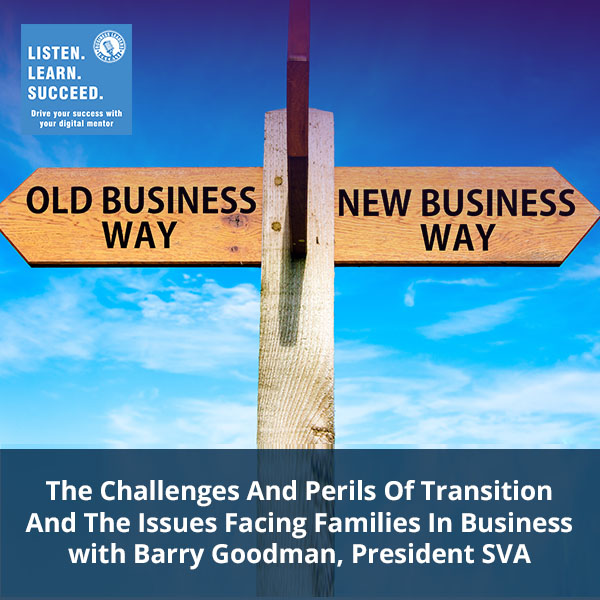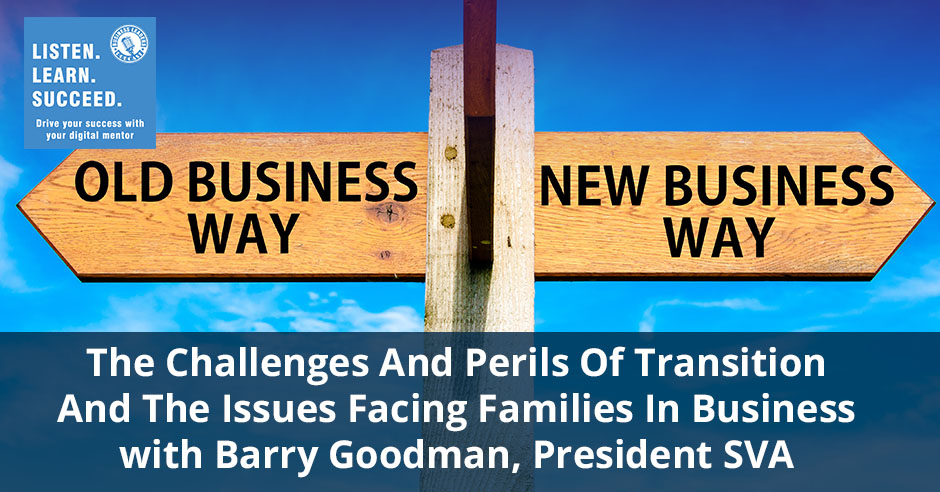The Challenges And Perils Of Transition And The Issues Facing Families In Business with Barry Goodman, President SVA


Sean Hutchinson and Barry Goodman, co-founders and partners with SVA Value Accelerators, do a deep dive continuation of the SVA episode as they talk about the challenges and perils of transition and the issues facing families in business. Sean is an expert in business value acceleration and transition readiness, while Barry is an expert in multigenerational family businesses with an advanced certificate in counseling family-owned businesses.
—
The Challenges and Perils Of Transition And The Issues Facing Families In Business with Barry Goodman, President SVA
Creating The Path To Higher Valuation with CEO/Partner Sean Hutchinson and Barry Goodman, President/Partner SVA Value Accelerators
We’re doing a deep dive continuation with Sean Hutchinson and Barry Goodman, Cofounders and Partners with SVA Value Accelerators. This is a continuation of the SVA episode. We’re going to dig deeper into this complex topic. We’re going to talk about the challenges and perils of transition and the issues facing families in business. Sean, let’s recap where this segment fits in.
Here’s the interesting thing about family-owned business in our value accelerator. If you think about our seven value accelerator sprints as vertical columns, family-owned business is the horizontal issue that cuts across all of them. It’s a different animal when you’re in a multigenerational family business. It’s great that we have on our team an expert in this area who is Barry. He’s got advanced certificates in counseling family-owned businesses. This as a resource that when we are working with a family-owned business, Barry’s expertise comes to bear. It cuts across all the sprints in value accelerator not just one but the constant issue when you are dealing with families.
Barry, why are the family-owned businesses so different than perhaps other businesses?
I believe you need to look at a Venn diagram where you have three circles. Family, business ownership and management reside in each of the circles and intersects with each other. This is the family business system. You have one circle and it talks about ownership and another circle is family and the third circle is the management of the business. You can have people that are members of the family that are not involved in the business and members of the family that are involved in the business. You can have members of the family who own shares but have no participation. We’re going to have family and employees that are employed that are not related by blood or marriage. There are all these different conflicts going on, different needs, different objectives of each of these different parties. As generations move from first to second to third and along with the history of the business, you put another circle around that and that’s called the cousin of consortium. It’s no wonder why this is a confusing area and an area where there could be conflict without intending to have a conflict because of the different needs, wants and objectives of each of the individual family members or nonfamily members.
That’s the pool that you’re navigating in.
It’s a big pool and it can get a little tenuous at times.
 Business Transitions: Transition-ready businesses are more valuable.
Business Transitions: Transition-ready businesses are more valuable.
In looking at the family business space, you were kind enough to provide a bunch of material for me to review. When you walk into a business situation where you’re working on value acceleration, what does that initial meeting or interaction with that business and/or family-owned business look like?
It is to understand what’s going on in the business and what’s going on in the family. It goes to the central theme that we have at SVA. We believe that transition-ready businesses are more valuable. The discussion is around the concept and the idea of transition readiness. Transition readiness consists of three things that we talk about. One is operational excellence, two is financial and three is, is that business being treated as an investment for the family or for the business owner? The concepts around how we treat a family business are no different. It’s just that we need to recognize that there are different goals and objectives that all need to be addressed with each of these different categories.
When talking about transition readiness and what does it mean. It includes operational excellence and financial efficiencies and looking at your business in terms of a dispassionate investor. Across the board in all businesses regardless of whether you’re a family-owned business or not, when you get down to it, look at your business through the eyes of an investor dispassionately for instance. It’s harder in family-owned businesses, potentially multigenerational with all of the competing interests or just different perspectives of family members to achieve that dispassionate position that allows you to look at it clear-eyed. Every owner is emotional regardless of whether they’re family owned or not. Every owner is somewhat emotional about their business. It’s their baby. They’ve invested a lot of their lifetime in it. When you throw the family dynamics into the picture that becomes even more difficult to achieve. The emotional currents that are running through the business in and out constantly, maybe old conflicts and they’re rearing their head again. It’s amazing what can come up in these situations and the investor’s perspective, it’s more difficult to settle into that viewpoint.
It is more difficult and it also relates to the operational excellence of the business. A business which is not family-owned would look for the best person they possibly can to fill the position that they may have within the company. The whole idea of the two aspects, bringing in a family member into the business just because they are family or are they the best person for that position versus bringing in an outsider. An outsider working in a family business has its own challenges both for the employee and for the business and for the family so that needs to be reconciled. That ties directly into looking at it as a dispassionate investor. That creates a lot of conflicts and a lot of discussion within families.
You’ve got the patriarch perhaps of the greatest generation or the Baby Boomer Generation. You may have the next generation that has been in the business for a while working their way up and starting to develop and demonstrating core competencies. You have the Millennial generation that’s behind that, not to mention the spouses that might be involved along the way. I think about the various viewpoints and aspirations of those various members. The patriarch is still present or some member of the family is present and they’re still making a living out of the business. You’ve got the next generation that’s functionally operating the business perhaps that has their own aspirations and input from their spouses. You had them thinking about maybe can they take and ask the business at some point to these young kids that maybe are just starting as they did. When you come into that organization, what do you do to start trying to address perhaps known landmines in that field?
A business which is not family-owned would look for the best person they possibly can to fill the position they may have within the company.
We need to drill down and understand what is in the mind of the patriarch. What are they looking to do? What’s next for them? We talk often about three legs of the stool. What is that life after business for the patriarch or matriarch in that family? How were they installing their values, their goals and their mission in the second and then possibly that third generation? You often see family businesses only lasting until that third generation. That goes to that patriarch who was the one that started that business from the trunk of his car or his garage developing values and then brought in to the next generation which is continuing the values. That third generation may not have an interest or maybe technology has changed. It’s understanding the goals and objectives and understanding the values of the family and how they fit in with the business because the business can’t just operate as a separate unit. They are intertwined especially in a family situation.
They always say that family issues will trump business issues every time. If you go into these situations and you think this is going to be like anything else, there’s going to be a rational dimension, just the business issues. Not to say that the family issues are irrational but they add a dimension to the environment which cannot be ignored. As an advisor, if you miss it, then you’re not doing a good job as an advisor. You’re wiping away this very important aspect. I do agree with Barry and one of the things that you were getting at, Bob. The shadow that the patriarch or matriarch has can be quite long in a family business especially if they’re first generation or founder generation in the business. They have an emotional investment and that entrepreneurial venture that the following generations will not have. Let’s acknowledge that right from the beginning.
However, where it was pointing at the values of the family are the things that are going to carry it forward because the business situations will change. The question is how good is the family at managing through that? How much of that knowledge and wisdom have they been able to transfer generation to generation and how have they done it? How has it gone? How good was the plan for that mobility of the values across multiple generations because it becomes more fragile as you move away from the founding point? It’s just more distance so it’s going to become less connected.
If you study families that are in their fifth, sixth, seventh or eighth generation, there are a number of those families that are still around or those businesses that are still in existence. They are successful because they’ve been able to discuss their values, discuss their mission and have a mission and vision and values not only within the business but within the family. The two must be in alignment with each other in order for that family and that business to succeed from generation to generation. It’s always fascinating to me to read and learn about how many have succeeded.
There are so many generations and statistics show that only 4% will last into that fourth generation and beyond. Also, to recognize that the business that you entered into when you were in your first generation may not be that same business that you have in that second, third or fourth generation for a number of reasons. It could be technology, it could be a change of interest. It could be a number of different things. A family may have somebody who wants to enter into the business and somebody in the family that does not want to enter into the business, but they want to go into a different business.
 Business Transitions: Statistics show that only 4% of family-owned businesses last into the fourth generation and beyond.
Business Transitions: Statistics show that only 4% of family-owned businesses last into the fourth generation and beyond.
In the progression, you start with family-owned business. That’s what you’d call it, a family-owned business but at some point along the way, you do become a business-owning family. That’s a subtle but very important shift where you might have multiple ventures going on within the family ecosystem. You may have become a more passive owner in your own business but you’re still a business-owning family. If they start to see themselves that way, it changes the conversation.
It changes the conversation and it also reduces the risk. Investments are about diversification so why not diversify your business interests and engage those family members who have an interest in technology with the Millennials? The younger generations have an interest in technology. Don’t fight that and look at developing the business-owning family.
Let’s say I’m that business owner and we’re going to pretend I’m the patriarch. I’ve got issues facing me and there’s the sibling rivalry that’s been there since day two. There are competing interests and competencies. I want to create a method or mechanism, or some go forward steps where my children are still friends after I passed. The business endures and there is some mechanism that the children get to deploy or exploit their particular skill sets. One may be a CEO, one may be a different business. What steps would you recommend that a patriarch or matriarch could take to start trying to get congruent in the family towards preserving what they’ve done?
You’ve seen a lot of this concept in Europe where it started. It’s not in its infancy but more and more families are forming family offices. They are looking at the entire business and the entire ownership of the family but it’s starting around the goals, values, and mission of the family. That is then going into the family office where they can foster this entrepreneurship within the family and different family members involved in different business interests. Yes, you will have conflicts among family members. It’s there but if you implement governance within the family as you do within the business, that helps provide a non-legal way of mitigating some of these conflicts and giving a mechanism of how conflicts are resolved. It develops a culture. If you develop a culture within the family to resolve conflicts, find common ground and then expand on that common ground to resolve issues as a family. We can’t be so blind to the fact that some conflicts will never be resolved. If you can come together around something, you are then able to operate the family interest and act as a family and at least get together on Thanksgiving at two sides of the table.
There are a couple of other things that you could think about as a family that anticipates multigenerational ownership or creating an entrepreneurial culture that may spawn multiple ventures. Dennis Jaffe, who is a well-known and respected in the area of family-owned business did a study on 100-year family enterprises. It means that there are at least three, four or five generations in the business and they made these tricky transitions each time to keep it together. Many of the things that Barry said were things that they did. They’re creating a family council constitution, figuring out what matters together, and figuring out how to make those tough decisions. It’s similar to what we talked about in our decision dynamics episode where we were applying it within a business. Some of these same principles have to apply within the family itself. What Dennis was looking for in his study are the common characteristics or the things that are happening in these multigenerational 100-year business families that are common across generations.
He found that the families that existed, their businesses made it to the sixth generation, which is so rare. They had done two things by the second generation. They had hired professional outside management and they had a board of directors with outside independent directors. Right from the beginning, the family had made the choice to implement professional best practices for operational excellence. The governance that carries the business forward beyond where the family could carry it if they were doing it themselves. I was fascinated by that. It was two factors that we knew made a difference but we didn’t know that it was going to be the two things that the sixth-generation families had done by the time they made their first transition of ownership.
There are families and there are businesses that have done exactly that, Sean. There is one business I can think of. They have no family members involved in the business whatsoever. From the board level down to the punch press. It’s treated truly as an investment and they have brought in professional management and they also have a board of directors. The family gathers however around philanthropy. I’m finding this more and more that families that are in their seventh or eighth generation are around the philanthropy or some other interests that they can do together.
There’s a point in any business no matter who the owners are whether it’s a business owning family or an individual or partnership or management team where they have to make a decision about letting go. They have to know their limits and understand like, “We’ve taken it this far and maybe it is the right thing to take it further as a family. Maybe we’ve got the talent. Maybe we’ve got the desire to move it forward across generations.” If you’re a multigenerational-thinking business family, then you’re going to say that this is not just about getting to the next generation. It’s about moving as a family in a multigenerational strategy well beyond. All of these conversations are happening. I would like to see them happening early in the process rather than having to have them while you’re trying to make an ownership transition because the chances of failure, going from one to two, founding generation to the second generation, is very high. The statistics are not good. I don’t see a whole lot of evidence that being a family business necessarily guarantees you a better success rate on subsequent generational transfers. The failure rate for nonfamily businesses and family businesses is pretty close.
I believe that it’s more difficult for a family-owned business to get to that next level and to get to that next generation. PricewaterhouseCoopers did a study. They do a study every two years of family-owned businesses throughout the world. They asked three questions. One question is, “Are you going to transition that business to the next generation, both the business and management? Are you going to transition ownership and bring in professional management? Are you going to prepare the company for sale?” There has been a spike in preparing the company for sale or they just don’t know what they’re going to do. There are two things in that third category. They don’t know what they’re going to do and they are going to prepare it for sale. It has almost doubled from 2014 to 2018. It’s fascinating to see that change.
Are you saying that family businesses are used to prefer intergenerational now that it’s clear that there’s a movement away from that towards we’re going to sell it to an outside party?
Yes.
What’s driving that? Did Pricewaterhouse talk about it?
 Business Transitions: You have to get an education. If you want to be in the executive ranks, you’ve got to have an MBA or some advanced degree.
Business Transitions: You have to get an education. If you want to be in the executive ranks, you’ve got to have an MBA or some advanced degree.
They talked about it and a lot of the issues are that new generation wanting to go into other types of businesses. It’s not that their family is getting out of being a business-owning family. It’s the business itself. At some point in time, you need to bring into the business outside management which is a very difficult thing to do. When it grows, you have different financial needs that are a drain on the business. The family grows at a faster rate than the business and the business can’t keep up with the growth of the family. Those needs of new family members put that pressure on the business. You take dividends for instance. If you have somebody who is not involved in the business but owns shares in the business, their goal and objective is they want money. They want some cash. If you have another family member who is in the business that also has ownership, their goal is to keep money in the business to grow the business.
If you keep looking at the Venn diagram and seeing and analyzing what the needs are of all these people and the pressures that are placed on the business, it’s no wonder that there’s conflict. The family businesses have a difficult time transitioning because of the needs of the growing family. A lot of families look at that business and they brought that next generation up to depend on that business. What a lot of families are doing is they’re also requiring their family members to get jobs outside of the business. They have requirements that allow them to come into the business that is no different than if they went to a third party to hire a third party to come in and work in the business.
That’s a good example of looking at your business through the eyes of an investor and how would a non-family business handle this to taking the family out of the picture. I’m assuming our audience have heard of Goya Foods. It’s a big family. It was a Cuban family that fled Cuba and they’re now based in Puerto Rico but it’s a sizable business. They have very structured rules and pathways for subsequent new generations to participate in the business and they put them through the paces. As Barry said, you have to go get an education. If you want to be in the executive ranks, you got to have an MBA or some advanced degree. They put money behind this process. It’s not like, “Go off and get your MBA and come back and talk to us.” They have enough wealth that they’re able to support this pathway for their children but there is no guarantee. They’re not going to make a job for a family member just because they’re family. They’re not going to put another box on the organizational chart. Either the job is open or isn’t open, it can be filled by a family member or filled by a nonfamily member and they’ll go through the interview process. By the time they get into the executive ranks, they need to have worked through the ranks of the company so that they can better understand the way the business operates.
That is what they call entry and exit provisions of the family constitution. The family constitution is the document which bridges the family to the business. It sets up those entry and exit provisions into the business so that the family and the business knows what their labor pool is. We’re in a situation now where the labor isn’t there. The family only has so many bodies and so many minds to utilize like the Goya family to be able to grow that business. It’s looking at this strategically and how are we going to grow the business and what are the resources that we have within the family and what do we need from the outside.
You were talking about instituting the family constitution and I think about that for second generation transition in the will of the patriarch to get this in place. The potential drawbacks and challenges of the next generation, looking at having to behave according to constitutional statements. When you call a family meeting, how do you institute some type of process in a structured manner?
It’s not an easy process to start. The family needs to be willing and have the vision to have that business want to be in the family for generations to come. I have seen it not within that first generation but more so in that second generation that wants to have that business within the family for the third and fourth generation. It requires a special type of family that has that vision. Let’s say I want my children and grandchildren to have the benefits of this business.
I see that in ag operations where they’re accumulating ground through the generations and there’s the typical angst that goes on within the family. What types of mechanisms do you see commonly used to arbitrate disputes within the family?
There’s the family council that can reconcile disputes. The family constitution gives you the methodology in which to do that. Oftentimes, outside mediators can be brought in depending upon the nature of that conflict. The provisions of the constitution are the written document but also within the family console, you have mechanisms in place that help you recommend these disputes or conflicts within the family.
One thing I need to make sure that I don’t forget is for the folks that go on like, “I need to reach out to you.” How do they find you all on social media?
We’re on LinkedIn. Our website is buildvaluetoday.com and they can always email one of us by looking at our website and getting our respective email addresses.
 Business Transitions: Certain families would benefit from being in a family-only mastermind group because they do have common interests and common problems.
Business Transitions: Certain families would benefit from being in a family-only mastermind group because they do have common interests and common problems.
We have a company LinkedIn page. You can follow us. We have individual LinkedIn pages, Barry Goodman and Sean Hutchinson and the other folks in our firm. It’s a great way to connect. We always love to hear from business owners and talk with business owners. We’re always fascinated by the story and the connection with our clients is an important thing for us.
One of the things that we talked about for the families, we need to work both on the family business and in the business itself to get things sorted out. You have something coming up at the first of the year 2019 I believe.
We’re starting a new exciting program called the Ready-for-Next Academy, an online live education for owners. Barry has been developing mastermind groups which are peer driven groups of ten owners working together over the course of a year and helping one another solve problems. That’s an expert-facilitated in a very structured program that follows our value accelerator and those seven sprints along with many other activities. We’re glad to get those things off the ground and introduced in our community.
Barry, when you think about mastermind groups, what would you think about family-owned businesses versus nonfamily owned businesses in a mastermind group? Would it be a benefit for segregating or not?
Certain families would benefit from being in a family only mastermind group because they do have a common interest and they do have common problems. On the other hand, they will also benefit from a nonfamily situation. If they are looking to continue their business from generation to generation, it gives them a good idea as to how nonfamily businesses are organized and how they operate. It is a little bit of a paradigm shift for families to look at some nonfamily situations.
I would see that as a great resource for finding members to be outside folks on your board.
There are other organizations that are specifically set up to provide board members both on a national and on the local level. I’m a member of the Private Directors Association. It is an association specifically set up to provide board members to both families and nonfamily companies and there’s a progression. A lot of families when they get into implementing a board, they may not want to have an outsider involved immediately. They have to understand the benefits of this. I usually recommend that they start with an advisory board, which is a non-fiduciary board and they can get the value of bringing in third parties. I’m not talking about bringing their buddies from the country club. They need to bring in people that can demonstrate the ability and the willingness to provide additional value. Once they see that and understand that value in there, they’re then more inclined to look at a formal fiduciary board with outside board members that can add real value and bring that to the company. A lot of the responses that I have gotten is, “This is the cheapest consultant I can ever hire.” It’s an advisory board or board of directors.
It brings up an interesting point. We talked about bringing outside management. We talked about bringing in a true board of directors with fiduciary responsibility oversight for the company. There’s a lot of authority that comes with that, a lot of risks for board members as well that they need to be aware. Often what comes with those decisions is a need to make room in the equity structure for nonfamily members. Let’s imagine it’s a $100 million family business. By the time you get to that point, you’ve hired outside professional management who should be operating with the board well before that. There aren’t a whole lot of executives who are true CEO types that will come into business without having some equity participation.
That doesn’t necessarily mean that it has to be the same type of equity as the family’s equity. It could be phantom equity at least in the beginning but they are going to want to have some ownership in the company and it’s often the case for board members too. I sit on boards and I have equity options in those companies. You’re into a situation where the family needs to think about proactively. How are they going to structure the equity in their company to allow for that and how are they going to get comfortable with it?
We talk about this often in our firm. If you are operating as an S corporation, you have a very little flexibility on that front and the best you’re going to be able to do most likely because you only have one class of stock to work with. The voting and the nonvoting but one class of stock with economic rights. You don’t have very much flexibility to bring in other equity partners at another non-founder level.
Most of the businesses in the Baby Boomer category are going to be operating as escorts and not LLCs where you have a lot more flexibility. They’re not operating a C corp although we do see it and we may see more of it now that the tax rates in the United States have adjusted on corporate tax. There could be benefits. It’s complex. Thinking proactively about that, what we’re going to have to do in order to allow for that is important.
Barry’s right on the advisory board. That’s a great place to start because you get to test your method a little bit or dip your toe in and find out what that feels like. When the transition comes from advisory to true governance, there is a difference. It is related but it’s a different animal. Here’s my opinion. A bad board, badly run, badly selected is a millstone around the neck of the company. It could do a huge amount of damage, so you need to know how to run a board and you need to understand the implications of running a board badly versus well. A lot of owners keep themselves in the chairperson’s position in many cases. That’s okay but the chairperson has specific responsibilities and authority within a board which are important to know how to wield effectively and fairly. I’ve seen companies make the mistake like, “It’s an advisory board. What we’re going to do is formalize it and we’re going to continue operating as an advisory board without stepping up our game.” That’s a serious mistake.
 Business Transitions: Whatever that investment looks like, begin now even if you think the transition is not in it.
Business Transitions: Whatever that investment looks like, begin now even if you think the transition is not in it.
- You need to look at the company, the board and the family altogether. You can’t just look at one piece without considering the vision, mission, goals, and objectives of all the parties and handling it with a plan to be successful for the next generation of owners. I have seen situations where a board has been disastrous for the company and to the family and it’s almost to the point of destroying the business. This is a big decision to make as bringing in a board, but it accelerates value tremendously. The families are very hesitant because they have a stranger or a third party that’s not involved in their business. To your point, the compensation policy around key outside members of the family business is important. If they’re exploring the value and they’re getting operational excellence in achieving that and achieving financial excellence in the business, you got to keep them somehow. The people will be pursued. Once the family has that relationship and is comfortable with an outsider, you don’t want to lose them. That’s a big deal. The outside members and the management team are a big deal as far as compensation goes.For both from a family perspective and other nonfamily owners, one of the things that a board can do that’s effective is develop a good dividend policy or distribution policy depending on the form of your company because it becomes a transparent tool. Generally speaking, it’s still at the discretion of the board to declare a dividend or distribution but having a policy takes some of the potential argument out of the situation. I remember one company that we worked with that had a very good dividend policy in place. It was a high cashflow company. They had confidence that they can meet the threshold of their dividend policy. They did it four times a year. They made distributions four times a year at the end of every quarter. Their policy was 30% of the earnings of the company in that quarter were distributed every quarter. You can’t do that with every business. There wasn’t terribly cyclical that profit was high and cashflow is high so you’ve got to line up with the realities of the business. I like the fact that they were right on the mark every time they kept their promise and they operated as a board. Barry talked about the difficulties of the board and the dangers of it. That doesn’t mean you shouldn’t do it. It just means you should do it well and get help if you need it. There are advisors who specialize in this area.There’s one more point I want to make on your conversation regarding dividend policies or distributing a certain percentage. The board needs to be responsible for the other agreements that the company has with family members. If a family owns the business and also owns the building and is paying rent, if you want to have a fair dividend policy, pay a fair rent. Most of the time the rent will be above the market which in effect is dividend policy. They may have the boat on the books or the summer cottage can be on the books. A lot of the families will use the company as their pocketbook and have these other assets. That in effect is dividend policy.
- You’re taking money out of the company at the expense of other shareholders.
- It’s a holistic approach that needs to be taken off.
- Starting early makes a difference. Waiting until the last minute is bad.
- Click To Tweet
- I come from a family business. I’ll be the third generation of ownership in our family business. We’re getting into that rarefied percentage of companies that survive past the second generation. This company is 63 years old. It’s a small company back in my hometown and the first transition didn’t go well. It was poorly planned and messy but we’re trying to make some progress towards making sure that doesn’t happen again. Even though this is my expertise, we’re still having difficult conversations about how that will work. We have formed a family board which is the first time that’s ever happened. We’ve had that in existence and it’s going okay. There are some next steps we need to make but here’s what I would say. We’ve talked about a lot of the challenges of a family business that it’s this different bird and it’s so exotic that we have to treat it and we have to hold in our hands very delicately. Family businesses have a lot of resilience to them because they’re family businesses. Families know each other and trust each other. There’s a great deal of empathy that may not be so present in nonfamily businesses.
- It’s a little bit of a contradiction. On the one hand, we want folks to look at their business through the eyes of an investor as dispassionately as they possibly can. On the other side, we want to cultivate and reward family behaviors that are ties that bind and bringing people together. When times get tough, it could go one or two directions. You could be a family that becomes even more dysfunctional or dysfunctional. You can be a family that leans on the shared values and experiences across generations of the family. Even though you’re going to disagree, use that to find a way. It’s a strength and we have to acknowledge that. Family businesses are not easy but they’ve got something that a lot of other businesses don’t have and that’s family.
- Is there anything that we missed that you wanted to talk about?
- We’ve hit some good highlights here. We can get more down into the weeds with a number of different topics but we hit a lot of the high points.
- We want to emphasize too in all the discussions that we’ve had, we’ve tried to make clear and maybe beat the dead horse a little bit that starting early makes a difference. Waiting until the last minute is bad. Don’t work against yourself. It’s not going to work out well. It started with value acceleration and creating transition readiness and working on these issues together. Make that investment. We encourage it. Whatever that investment looks like, begin now even if you think the transition is not in it. Even if it’s ten years off, transition ready businesses are more valuable. That’s what we believe because they run better. They’re more disciplined because they’re thinking strategically. Just keep that in mind. Planning of all kinds makes a difference. We know that it increases the odds of success.
- Planning goals incongruence.
- It’s a business strategy.
- It’s just good business. You never know when somebody is going to knock on that door and use life-changing money to buy your business.
- Given the commentary, I appreciate your time, Barry and Sean. Hopefully, if they get nothing else out of all of this is do something. Sooner is better than later and if you don’t know what to do, there are resources. The worst mistake you can make is not reaching out because these guys are available and you can reach them by phone or email or on LinkedIn. I appreciate you taking the time.
- Links Mentioned:
- SVA Value Accelerators
- LinkedIn – SVA Value Accelerators
- Barry Goodman
- Sean Hutchinson
- Ready-for-Next Academy
- Private Directors Association
- http://BuildValueToday.com/
- About Barry Goodman
About Barry Goodman

I grew up in a business-owning family. My father was a distributor of electrical supplies and lighting fixtures in the northwest suburbs of Chicago. Through the experience of working in my father’s business, at a very young age, the challenges of being a family in business are engrained in my soul.
Having chosen not to go into my family’s business, I became a Certified Public Accountant and owned my own CPA firm for over 20 years and then did my own transition to be a founding partner in a firm that grew to become one of the most successful middle-market firms in Chicago. The lessons I learned from the business owning families I served, enabled me to gain a reputation for recognizing a business’ strengths and challenges and identifying what could hold it back or push it to the next level. Seeing business owners make good and poor business and transition choices made me realize I had a passion for families-in-business, and I decided to focus my expertise and hands-on experience on a disciplined approach and process tailored to families and non-family stakeholders.
About Sean Hutchinson

Over my 25+ years in business, the best lessons I’ve learned have been from business owners who have generously shared their stories of success and struggle and allowed me to offer insights and guidance based on my experiences.
We share a bond. I’ve founded five companies, all of them with partners, some more successful than others. I’ve led a fast-growing global company as a very green, but hard-working and quick-learning, 34-year-old who every day had to make big decisions with big implications. It became the largest firm of its kind in the world. And, maybe most importantly, in this case, I’m the 3rd Generation heir to my family’s 62-year-old custom millwork manufacturing business. I’ve sat in your chair many times and I love being an entrepreneur.
As one of the three founders of SVA, my role is once again to fulfill the responsibilities of the Chief Executive Officer. I focus on strategy and growth – in other words, our Company of the Future. And that’s where I help our clients too – working with owners and their leadership teams to imagine what could be, can be, and will be their Company of the Future. I see my work as transformational, not just transactional. It’s all about getting you “Ready for Next.”
Join the Business Leaders Podcast Community today:
- businessleaderspodcast.com
- Business Leaders Facebook
- Business Leaders Twitter
- Business Leader LinkedIn
- Business Leaders YouTube
The post The Challenges And Perils Of Transition And The Issues Facing Families In Business with Barry Goodman, President SVA appeared first on My podcast website.